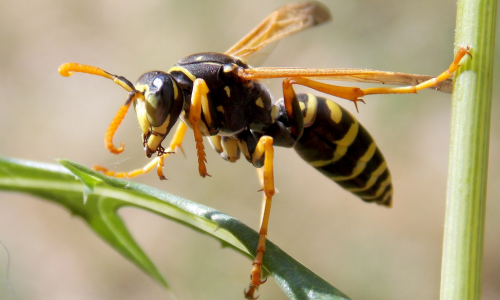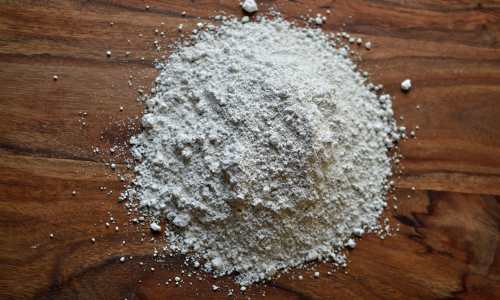Updated on June 5th, 2025
Wasps are never fun to encounter. Their painful stings are enough to send you running. What do you do, though, if you find a wasp nest near your home? How do you safely get rid of it? What natural product can you use to say farewell to those pesky invaders that are trying to destroy the peace in and around your home?
When dealing with ground wasp nests, a targeted application of insecticidal dust—such as diatomaceous earth—can help control wasp activity. While it's not guaranteed to eliminate the entire colony, applying DE at nest entrances may help reduce numbers over time by affecting active foragers and defenders. Food grade DE powder is safe to use around children and pets when used as directed.
>>> Try our bulb duster for diatomaceous earth, backed by Dr. Killigan's 100% Satisfaction Guarantee
Note: This article focuses on social wasps—known for their defensive nature and common presence around homes. It does not cover solitary wasps, which are less aggressive and do not defend a colony, focusing instead on individual prey.
What are social wasps?

Social wasps include paper wasps, hornets and yellowjackets. They live in organized societies, each with a set task that they diligently carry on. The queen, or queens, produce the offspring, while the other members—the queen’s non-reproductive daughters—care for the young, defend the nest and gather food.
There are about 20 types of social wasps in North America. They are in the family Vespidae and typically fall into the three aforementioned groups: paper wasps, hornets and yellowjackets. Many social wasps are large, can be quite aggressive and have frightening stings. They use their stingers, which can sting repeatedly, to protect and defend their colony.
Social wasps commonly have narrow wings that fold and build a new nest, either above ground or below ground, of recycled wood fibers every year. The fertilized queen wasps, living for up to a year, are the only wasps to overwinter. All of the other workers, who have a shorter lifespan of less than one month, die with the first frost.
Fun fact: Social wasps are more than just pests. Wasps and hornets keep wild yeast alive during the winter and prey on caterpillars, leaf beetles and other insects to keep pest populations down. Yellowjackets, like a cleaning service, forage for dead insects to feed their offspring and prevent bodies from piling up.
What is diatomaceous earth (DE)?
Diatomaceous earth is a fine powder that is made up of the skeletal remains of diatom fossils. It was formed as ancient diatoms—tiny, aquatic organisms that are made up of a natural substance called silica—died and settled to the bottom of rivers, streams, lakes and oceans. Today, silica deposits are mined from these areas.
On a microscopic level, DE looks like a multitude of tiny hollow cylinders covered in barbs. These microscopic abrasive shards can’t hurt humans or animals, but they can and will cause harm (and cause death) to insects that have exoskeletons, including fleas, ants, bedbugs and social wasps. They do so by scratching and piercing the waxy coating that covers the insect’s body.
DE also harms the insect internally; the tiny dust particles cling to any insect that comes into contact with it. When the insect later grooms the powder off their bodies, it poisons them as the DE builds up in their system—they can neither digest nor excrete the substance—and death comes through dehydration. Death, though, does not come instantly. Depending on the insect, it may take several hours to several days.
How is DE used?
There are numerous uses of diatomaceous earth. It has been known for controlling internal parasites, as a dewormer for pets, as pet and livestock protector against ticks and fleas, to prevent insects from entering your home, as an ingredient in toothpaste, for plant health, as a skin exfoliator, to preserve food, as a natural wasp killer and the list goes on and on.

Because of its many uses and benefits, it's a brilliant household product to have in your home. It’s great when you run into an issue—like having stinging, aggressive wasps too close to your home—and already have exactly what you need (a natural wasp killer) right in your cupboard.
In using diatomaceous earth, either as a pest control product, for health benefits or for any of these other uses listed above, we highly recommend the use of food-grade diatomaceous earth. Food-grade DE is a freshwater form of diatomite. It is safe, purified and has low levels of silica. It can be used around your home, your children and your pets. There is also filter-grade (or pool-grade), which is inedible but has many industrial uses.
What should I know about wasp nests? How do I identify them?
When removing wasps from your home or property, it's important to know where social wasps typically build their nests. While the appearance of their homes may be similar, the locations are not.
Note: Paper wasps, hornets and yellowjackets craft their nests from a paper-like mixture of chewed wood fibers and their saliva.
Paper wasps: Their nests resemble upside-down umbrellas hanging from short stalks. They are typically small and are built in shaded, high, protected sites like the eaves and overhangs of a building. More specific locations are behind shutters, under window ledges, in vents, attics, porches or sheds. Paper wasps will also build their nests in outdoor equipment like gas grills, swing sets and lawn tractors. Often, they are not concealed.
Hornets: Their nests—most commonly a bald-faced hornet’s nest—look like bloated gray footballs. They are usually located in wooded areas, attached high up on a tree branch or are on a large, outdoor tree-like shrub. They may also be found under the eaves of houses.
Yellowjackets: They build nests similar to hornets, except that the opening can’t often be seen and they are either built underground or close to the ground. They are commonly found in rodent burrows, in hollow logs or tree stumps. Closer to your home, their nests may be found between walls, under porches or steps and even in large sidewalk cracks.

How to use diatomaceous earth to kill wasps?
Getting rid of paper wasps, hornets and yellowjackets—and their nests—without being stung is possible if you remain calm and cautious. Wasps won’t generally sting unless they perceive a threat to their home, so move quietly and discreetly.
These steps are based primarily on expert advice for treating ground nests—such as those found in lawns, gardens or near foundations. For aerial nests, additional precautions or approaches may be needed.
To further prevent wasp stings, consider suiting up. Use duct tape to secure your pant legs to your boots or socks and your sleeves to your gloves and wear an extra layer of clothing, as wasp stingers can penetrate through one layer of clothing.
Follow these steps:
- Locate areas: Find the areas in your yard where you traditionally have had wasp issues.
- Time your approach: Wait until dawn or dusk when wasps are least active.
- Apply DE: Use Dr. Killigan’s Insect Buster Bulb Duster, filled with diatomaceous earth. Puff a thin, even layer directly in and around the nest entrance. Avoid heavy piles—wasps may avoid them. A fine dusting is more effective and more likely to go unnoticed.
- Monitor wasp activity: DE is not a chemical and does not lose potency or evaporate, maintaining effectiveness over several days. If needed, apply a second application after about a week. Reapply after heavy rainfall.
How can Dr. Killigan's help?

The Insect Buster from Dr. Killigan's, the most effective tool for dispersing diatomaceous earth and Dust to Dust Plant-Powered Insect Powder on the market today, is a compact-sized bulb duster that packs a wallop. With the Insect Buster, you can get rid of wasps—among other insects—with ease. Like all of Dr. Killigan's pest control products, the Insect Buster is backed by our 100% Satisfaction Guarantee, giving you the peace of mind that if they don't live up to your expectations, you can return them for a replacement or full refund.
Final word on using DE against wasps
When applying DE powder, it's crucial to wear appropriate protective gear. I recommend gloves, long-sleeved shirts, pants and a mask to prevent skin and respiratory irritation. However, once the dust has settled, additional protective wear is not necessary. Remember, the effectiveness of diatomaceous earth extends well beyond the initial application, providing lasting protection against pests without the use of harsh chemicals.





















